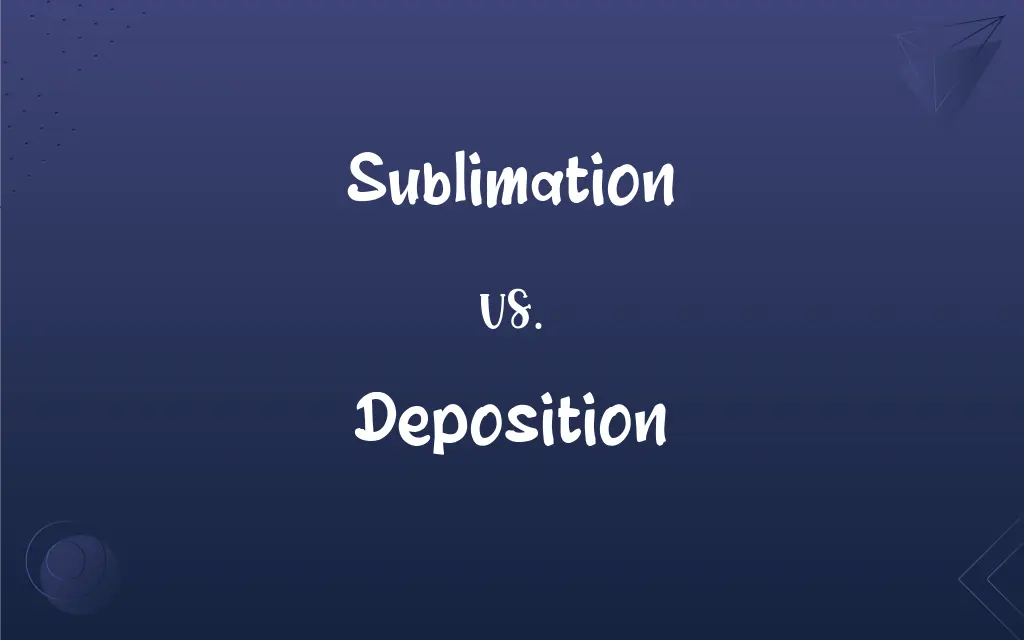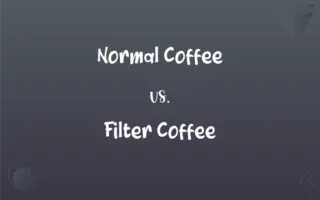Sublimation vs. Deposition: What's the Difference?
Edited by Aimie Carlson || By Janet White || Published on February 7, 2024
Sublimation is the process where a solid turns directly into gas, while deposition is the reverse, where gas turns directly into a solid.

Key Differences
Sublimation is a phase transition in which a solid changes directly into a gas without passing through a liquid phase. Deposition, conversely, is the process where a gas transforms directly into a solid, bypassing the liquid stage.
Sublimation occurs under specific conditions of temperature and pressure, often requiring heat absorption. Deposition happens under conditions where gas molecules lose energy and transition directly to a solid state.
An example of sublimation is dry ice turning into carbon dioxide gas. Frost formation on cold surfaces exemplifies deposition, as water vapor in the air turns directly into ice.
Sublimation is used in freeze-drying and printing industries. Deposition plays a crucial role in manufacturing processes like snowflake formation and thin-film deposition in electronics.
In sublimation, molecular bonding becomes weaker, allowing solids to turn into gas. In deposition, gas molecules slow down, increasing intermolecular attraction, resulting in solid formation.
ADVERTISEMENT
Comparison Chart
Phase Transition
Solid to gas without becoming liquid
Gas to solid without becoming liquid
Energy Requirement
Typically requires heat absorption
Involves release of energy
Environmental Conditions
Occurs under low pressure or high temperature
Happens at low temperatures or high pressure
Examples
Dry ice turning into CO2 gas
Frost formation from water vapor
Applications
Freeze-drying, sublimation printing
Snowflake formation, thin-film electronics
ADVERTISEMENT
Sublimation and Deposition Definitions
Sublimation
Sublimation printing involves transferring designs onto fabric or materials using heat.
The custom t-shirts were made using sublimation technology.
Deposition
In legal terms, deposition refers to the sworn testimony of a witness outside of court.
Her deposition was crucial in the court case's outcome.
Sublimation
Sublimation in chemistry involves a solid changing its state to a gas under specific conditions.
Naphthalene balls in wardrobes sublimate, leaving no residue.
Deposition
Deposition in physics involves gas particles forming a thin film on a surface.
In microelectronics, deposition is used to create circuit paths.
Sublimation
Sublimation is the transition of a substance directly from the solid to the gas state.
Dry ice sublimates at room temperature, releasing carbon dioxide gas.
Deposition
Deposition is the phase change from gas directly to solid without becoming liquid.
Snowflakes form by the deposition of water vapor in clouds.
Sublimation
In psychology, sublimation refers to channeling unacceptable impulses into socially acceptable activities.
He used sublimation by redirecting aggressive energy into sports.
Deposition
Deposition in geology is the process of sediment settling and accumulating in a new location.
The river's flow slowed, leading to the deposition of sediments.
Sublimation
Sublimation is used in freeze-drying food, preserving its nutritional value.
The process of sublimation is crucial in making freeze-dried fruits.
Deposition
Deposition in chemistry is the settling of particles or sediment from a solution.
The chemical reaction resulted in the deposition of a precipitate.
Sublimation
To be transformed directly from the solid to the gaseous state or from the gaseous to the solid state without becoming a liquid.
Deposition
The act of deposing, as from high office.
FAQs
What is sublimation in simple terms?
Sublimation is when a solid turns directly into a gas, skipping the liquid stage.
What is deposition in simple terms?
Deposition is when a gas turns directly into a solid without becoming liquid.
Are sublimation and deposition opposite processes?
Yes, sublimation and deposition are opposite phase transitions.
Can all solids sublimate?
Not all solids; only those with specific properties like dry ice can sublimate.
What conditions are required for deposition?
Deposition usually occurs at low temperatures or high pressure.
What is a practical use of sublimation?
Freeze-drying food for preservation is a practical use of sublimation.
What conditions are required for sublimation?
Sublimation typically requires low pressure or high temperature.
What is the role of temperature in deposition?
Lower temperatures generally encourage deposition.
What is an example of deposition in nature?
Frost formation from water vapor is a common example.
Can sublimation occur at room temperature?
Yes, for certain substances like dry ice, sublimation can occur at room temperature.
What is the role of pressure in sublimation?
Low pressure can facilitate the sublimation process.
Is sublimation common in the Earth's atmosphere?
It's less common than other phase changes but does occur.
What is an example of sublimation in daily life?
An example is the sublimation of air fresheners from solid to gas.
Does deposition happen quickly?
The rate of deposition depends on the environmental conditions and the substance.
Are deposition and condensation the same?
No, deposition is gas to solid, while condensation is gas to liquid.
What factors affect the rate of deposition?
Temperature, pressure, and the nature of the gas affect the deposition rate.
How is deposition used in electronics?
Deposition is used to create thin films in electronic circuits.
Is frost an example of deposition?
Yes, frost is formed by the deposition of water vapor into solid ice.
Can deposition be reversed?
Yes, through sublimation, deposition can be reversed.
How is sublimation used in printing?
In sublimation printing, ink turns into gas to transfer designs onto materials.
About Author
Written by
Janet WhiteJanet White has been an esteemed writer and blogger for Difference Wiki. Holding a Master's degree in Science and Medical Journalism from the prestigious Boston University, she has consistently demonstrated her expertise and passion for her field. When she's not immersed in her work, Janet relishes her time exercising, delving into a good book, and cherishing moments with friends and family.
Edited by
Aimie CarlsonAimie Carlson, holding a master's degree in English literature, is a fervent English language enthusiast. She lends her writing talents to Difference Wiki, a prominent website that specializes in comparisons, offering readers insightful analyses that both captivate and inform.







































































